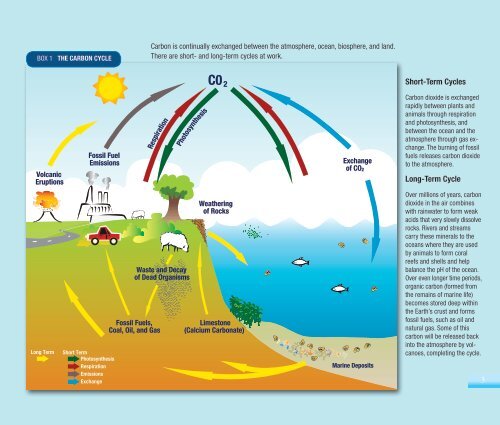OCEAN ACIDIFICATION Starting with the Science
SUMMARY DOCUMENT-Ocean Studies Board The National Academies—the National Academy of Sciences
SUMMARY DOCUMENT-Ocean Studies Board The National Academies—the National Academy of
Sciences
You also want an ePaper? Increase the reach of your titles
YUMPU automatically turns print PDFs into web optimized ePapers that Google loves.
BOX 1 THE CARBON CYCLE<br />
Carbon is continually exchanged between <strong>the</strong> atmosphere, ocean, biosphere, and land.<br />
There are short- and long-term cycles at work.<br />
Volcanic<br />
Eruptions<br />
Long Term<br />
Fossil Fuel<br />
Emissions<br />
Short Term<br />
Photosyn<strong>the</strong>sis<br />
Respiration<br />
Emissions<br />
Exchange<br />
Respiration<br />
Waste and Decay<br />
of Dead Organisms<br />
Fossil Fuels,<br />
Coal, Oil, and Gas<br />
Photosyn<strong>the</strong>sis<br />
C0 2<br />
Wea<strong>the</strong>ring<br />
of Rocks<br />
Limestone<br />
(Calcium Carbonate)<br />
Exchange<br />
of CO2<br />
Marine Deposits<br />
Short-Term Cycles<br />
Carbon dioxide is exchanged<br />
rapidly between plants and<br />
animals through respiration<br />
and photosyn<strong>the</strong>sis, and<br />
between <strong>the</strong> ocean and <strong>the</strong><br />
atmosphere through gas exchange.<br />
The burning of fossil<br />
fuels releases carbon dioxide<br />
to <strong>the</strong> atmosphere.<br />
Long-Term Cycle<br />
Over millions of years, carbon<br />
dioxide in <strong>the</strong> air combines<br />
<strong>with</strong> rainwater to form weak<br />
acids that very slowly dissolve<br />
rocks. Rivers and streams<br />
carry <strong>the</strong>se minerals to <strong>the</strong><br />
oceans where <strong>the</strong>y are used<br />
by animals to form coral<br />
reefs and shells and help<br />
balance <strong>the</strong> pH of <strong>the</strong> ocean.<br />
Over even longer time periods,<br />
organic carbon (formed from<br />
<strong>the</strong> remains of marine life)<br />
becomes stored deep <strong>with</strong>in<br />
<strong>the</strong> Earth’s crust and forms<br />
fossil fuels, such as oil and<br />
natural gas. Some of this<br />
carbon will be released back<br />
into <strong>the</strong> atmosphere by volcanoes,<br />
completing <strong>the</strong> cycle.<br />
3


